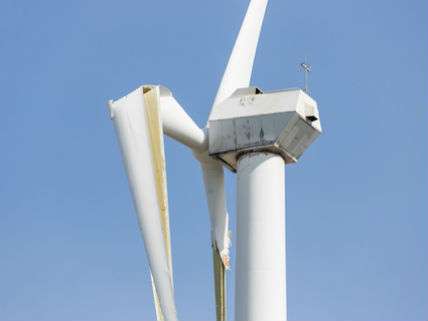Powering U.S. Using 100 Percent Renewable Energy Is a Total Fantasy
New research debunks a study claiming there's a low-cost way to power America using only wind, solar, and hydropower.

Wind and solar power backed by hydropower and underground thermal storage can supply 100 percent of Americans' demand for energy by 2055 at a low cost, if you believe a 2015 study in the Proceedings of the National Academy of Sciences. Hydrogen would supply most of our energy needs for manufacturing and transportation. No natural gas, nuclear power, biofuels, or stationary batteries would be needed.
Sound like a pipe dream? It is.
The study, put together by a team of Stanford engineers led by Mark Jacobson, was widely hailed by environmental activists as the solution to climate change. But this week a new study in the same journal makes a strong case that Jacobson's paper is mostly bunk. According to the new article, the Jacobson study "contains modeling errors; incorrect, implausible, and/or inadequately supported assumptions; and the application of methods inappropriate to the task. In short, the analysis performed [by Jacobson and his team] does not support the claim that such a system would perform at reasonable cost and provide reliable power."
When I read a similar Jacobson plan from 2013, claiming that we could "repower" America using only renewables by 2030, I reached basically the same conclusions. Electric generation alone—a 1,000-gigawatt sector that eats up 40 percent of America's primary energy consumption—couldn't be converted to zero-carbon renewable energy sources without installing 15,000 new wind turbines, 155 solar photovoltaic plants, and 190 concentrated solar power plants each year. Even assuming steep declines in the costs of each form of renewable electric power generation, such a repowering would cost roughly $7 trillion by 2030. The Information Technology and Innovation Foundation calculated that the total cost of Jacobson's 2013 scheme would amount to $13 trillion.
Keep in mind that the total asset value of the entire U.S. electrical system, including generation, distribution, and transmission, amounts to less than $1 trillion.
The new version of the repowering plan would involve installing 335,000 onshore wind turbines; 154,000 offshore wind turbines; 75 million residential photovoltaic systems; 2.75 commercial photovoltaic systems; 46,000 utility-scale photovoltaic facilities; 3,600 concentrated solar power facilities with onsite heat storage; and an extensive array of underground thermal storage facilities.
Let's briefly consider a few of the damning criticisms of Jacobson's repowering scheme made in the new article:
• The Jacobson study assumes a total of 2,604 GW of storage charging capacity, more than double the entire current capacity of all power plants in the United States.
• It assumes that underground thermal energy storage systems will be deployed in nearly every community to provide services for every home, business, office building, hospital, school, and factory in the United States. The largest such facility today stores 0.0041 terawatt-hours of energy; the plan requires enough plants to store 514.6 terawatt-hours.
• It assumes the ability to store in hydrogen an amount of energy equivalent to more than one month of current U.S. electricity consumption. Furthermore, hydrogen is supposed to be produced at a peak rate consuming nearly 2,000 gigawatts of electricity—nearly twice the current U.S. electricity-generating capacity. It assumes the widespread use of hydrogen to fuel airplanes, rail, shipping, and most energy-intensive industrial processes, including steel and cement manufacturing.
• Because wind and solar power are highly variable, the repowering plan assumes that 63 percent of all energy-intensive industrial demand is highly flexible. It assumes workers and suppliers can be called in or sent home to match the availability of energy inputs any time of day or night.
• It assumes a cost of capital at unrealistic discount rates of 3 to 4.5 percent per year rather than more realistic discount rates of 6 to 9 percent per year. The more realistic rates double the estimated cost of electricity, from 11 to 22 cents per kilowatt-hour.
• At the average power densities, the scale of wind power envisioned by Jacobson and his colleagues would require nearly 500,000 square kilometers of land. That's roughly 6 percent of the continental United States. It also assumes there will be no delays in installing more than 150,000 wind turbines offshore, though those usually rouse public opposition.
• Judging from how fast energy generation infrastructure has been installed in the past, the repowering plan would require a sustained installation rate that is more than 14 times the U.S. average over the last 55 years and more than six times the peak rate.
The new paper concludes that Jacobson's scenarios "can, at best, be described as a poorly executed exploration of an interesting hypothesis." Jacobson's claims, the authors continue, "are not supported by adequate and realistic analysis and do not provide a reliable guide to whether and at what cost such a transition might be achieved." As a result, "Policy makers should treat with caution any visions of a rapid, reliable, and low-cost transition to entire energy systems that relies almost exclusively on wind, solar, and hydroelectric power."
That's basically what I said in 2013.
Show Comments (213)